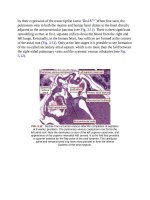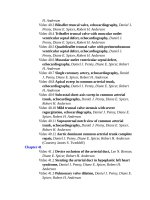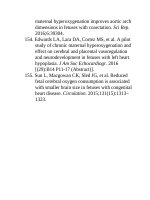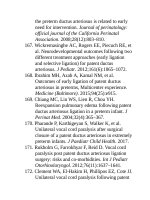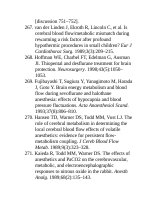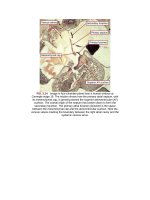Andersons pediatric cardiology 1855
Bạn đang xem bản rút gọn của tài liệu. Xem và tải ngay bản đầy đủ của tài liệu tại đây (85.05 KB, 3 trang )
decreaseinmyocardialVO2(shiftstheventricularpressure/volumeloopdown
andtotheleft,illustratingareductioninmyocardialO2demand).Idealagents
forthisstrategyincludenitroprusside,andthecombinedinodilatormilrinone.
Optimizingthehematocrit(40%to45%)andensuringadequateionizedcalcium
areimportant;thelatterisofparticularimportancefortheneonatal
cardiomyocyte.Thepatientwithrespiratorydistressandmarginalcardiacoutput
shouldundergointubationandmechanicalventilationasdescribedearlier.In
additiontoaddressingimpairedgasexchange,replacingexaggeratednegativepressurebreathingwithpositiveITPreducessystemicventricularafterloadwhile
unloadingtherespiratorypump,allowingforaredistributionofthelimitedCO
toothervitalorgans,whileimprovingtherespiratorymuscle,myocardialand
globalVO2/DO2relationship.47a
Asecondcauseforclinicaldeteriorationissystemic-to-pulmonaryartery
shuntmalfunction.ThisisclinicallymanifestedbyadecreaseinPaO2/SaO2,
resultinginsystemichypoxemia.BecauseimpedancetoQpiselevated,Qsis
preservedandcompensatesforadecreaseinCaO2untilthefallinCaO2reaches
acriticalpoint.TheSaO2decreases;however,theO2ERremainsnormaluntil
thefallinCaO2becomessevereenoughthatthecompensatoryincreaseinQsno
longersufficesandtheO2ERbeginstoincrease.BecauseQpislimited,the
spontaneouslybreathingneonatecompensatesbyincreasingminuteventilation.
IntheneonatereceivingPPVandafixedminuteventilation,thearterial-toendCO2gradientbecomeselevated(>5to10mmHg),consistentwith“wasted”
ventilation.Temporizingmeasuresincludeacuteanticoagulationandincreasesin
thesystemicarterialpressurewiththeadministrationofvasopressorssuchas
norepinephrine(providessignificantinotropicsupportaswell),phenylephrine
andvasopressin.Increasingairwaypressureandminuteventilationmaybeof
somebenefitbyincreasingCO2excretion,oritmayincreasetheextentof
wastedventilation,limitingornegatingthebenefitoftheincreaseinminute
ventilation.AsITPrises,thepressuregradientforsystemicvenousreturnmay
diminish.Ifalveolibecomeoverdistended(creatingzone1and2conditions),
impedancetoQpincreasesfurther.Anechocardiogrammaydemonstratepartial
shuntocclusionbyathrombosisoranarrowingoftheshuntotherwise;however,
thesensitivityofanechocardiogramdemonstratingsuchalesionislowandecho
shouldnotbeusedtoruleoutshuntmalfunction.Thecardiaccatheterizationand
surgicalteamsshouldbenotifiedimmediately,asanurgentinterventionmaybe
indicated.
AcuteDeterioration,CardiacArrest,and
MechanicalCirculatorySupport
Inbothoftheseclinicalscenarios—lowsystemiccardiacoutputandprogressive
hypoxemiafromshuntthrombosis—progressiontocardiacarrestiscommon.
ForbothNorwood-typepalliationaswellasisolatedaortopulmonaryshunt
placement,ECMOistypicallyusedinbetween8%and12%of
patients.163,165,168–170Standardresuscitativemaneuversincludingmedications
andchestcompressionsaretypicallyunsuccessful,asthemechanismstoprovide
oxygenationandcirculationthathavebeenwellstudiedinapatientwitha
structurallynormalheartarevastlydifferentinthebabywithafUVHand
multidistributioncirculation.Chestcompressionsareunlikelytoprovide
pulmonarybloodflowthroughashuntinthesamemanneraspulmonaryblood
flowisprovidedduringchestcompressionsinabiventricularcirculation.
Additionally,forwardventricularoutputduringchestcompressionsislikelyto
becompromisedbyAVvalveregurgitation,whichissocommoninthesebabies.
Furthermore,theeffectivenessofcardiopulmonaryresuscitation(CPR)maybe
compromisedbydelayedsternalclosure,bleedingwithreducedoxygen-carrying
capacity,andsignificantlyreducedintravascularvolume.Ifpossible,avoiding
thecardiacarrestwiththepreemptiveuseofECMOmaybeofvalue.Inmany
casesthisinvolvesaparadigmshiftfrom“ECMOasrescue”to“ECMOas
treatment”forastateoflowDO2—typicallyfromundercirculationofthe
systemicorpulmonaryvascularbeds.Tothisend,manypediatriccardiovascular
centersarebeginningtostudyandimplementcardiacarrestreductionstrategies
forpatientswithcardiovasculardisease,similartothoseimplementedingeneral
inpatientpediatrics.
Themostcommoncausesofcardiacarrestinthispatientpopulationare
residuallesionsresultinginlowcardiacoutput(e.g.,systemicoutflow
obstruction,valvarregurgitation),excessivepulmonarybloodflowatthe
expenseofsystemicbloodflow,airwaycompromise,bleeding,tamponade,
arrhythmias,andshuntthrombosis.Promptrecognitionandtheinitiationof
standardresuscitativemeasuresareessential;butinthepatientwithafUVHand
multidistributioncirculation,inabilitytoachieveareturntospontaneous
circulationwithconventionalmeasuresiscommon.Ifapromptreturntostable
circulationisnotachievedwithinminutes,theuseofrescueECMOshouldbe
considered.TheuseofrescueECMOincircumstancesofcardiacarresthas
cometobetermedextracorporeallifesupportduringcardiopulmonary
resuscitation,oreCPR,andisapotentiallylifesavinginterventiontoreverse
refractorycardiopulmonaryarrest.
Rapidinitiationofcirculatorysupportisessentialtoasuccessfuloutcome.For
thepatientintheearlypostoperativeperiodfollowingasternotomyincision,
centralcannulationmaybethemostexpeditiousmethodofinstitutingECMO.
However,duringCPR,thisresultsincriticalinterruptionsofflow.Forthe
patientwhoismoreremotefromsurgeryorisreceivingCPR,neckcannulation
maybeused.Althoughthevariousinstitutionswillusedifferentapproaches,
therehasbeenlittleresearchoncriticalECMOsettingssuchasappropriate
ECMOflowrates,degreeofPPV(“rest”settingsvs.activeventilation),wholebodycooling,antibiotics,nutrition,andmanymore.Ingeneral,fortheneonate
withacardiacsourceofpulmonarybloodflowsuchasnativepulmonary
stenosis,abandedpulmonaryarteryoraNorwoodwitharightventricle-topulmonaryarteryconduit,initialECMOflowratesof120to140mL/kgper
minuteprovideasystemicbloodflowofonly~1.5to2.0L/minpersquaremeter
(normalbeing2.5to5.0L/minperm2);however,therewillbeadditional
systemicbloodflowifthereisanyejectionfromtheventricle.Importantly,
providingadequatesystemicbloodflowforthepatientwithshunt-dependent
pulmonarybloodflowonECMOcanbechallenging.Maintaininganopenshunt
hasbeenassociatedwithimprovedlungfunction.52However,flowratesof120
to140mL/kgperminutewillprovidesignificantlylesssystemicbloodflowasa
percentage(differentineverypatient)ofthetypical1.5to2.0L/minperm2of
theECMOoutputwillbedirectedtothelungs(throughtheshunt)insteadofthe
body,reducingsystemicbloodflowandDO2evenfurther.Ventilatory
maneuverstoincreasePVR,suchaslowinspiredfractionofoxygenand
hypoventilation,maybehelpful.However,inthepresenceofasignificant
“runoff”throughtheshunt,physicalreductionofshuntflowwithclipsor
banding53maybenecessarytoprovideadequatesystemicbloodflow.Rather
thanusinga“standard”of100to150mL/kgperminute,ageneralapproach
shouldbetakentoprovidethemaximalflowratespossiblefromtheECMO
circuitthatdoesnotrequiresignificantadditionalvolumetomaintain,doesnot
causehighoutflowpressures,anddoesnotcausehemolysis.Unfortunately,total
ECMOoutputisgenerallylimitedbyintravascularvolumestatusand/orthesize
ofthecannulas.
EarlyafterinitiationofECMO,thepatientshouldundergoechocardiography
